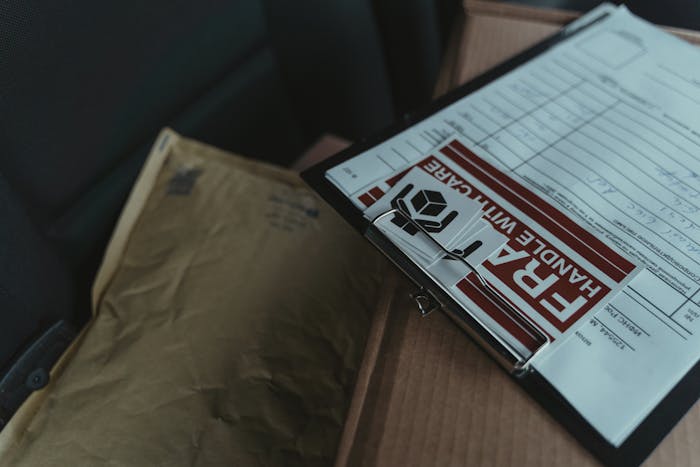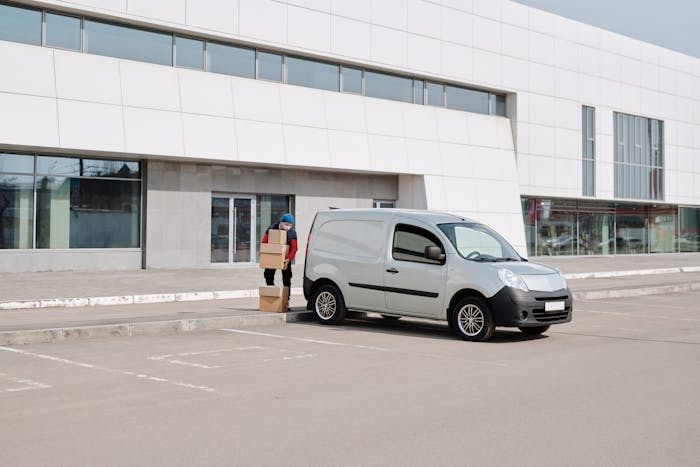If you work in the delivery industry, you've probably encountered the terms "logistics" and "distribution."
Although these words may appear interchangeable, they hold distinct meanings.
Think about the laptop or mobile device you're using to read this post.
Chances are, it was probably manufactured in a Chinese factory and subsequently transported across the sea to a central warehouse in the United States.
Shortly after, it moved from the central warehouse to one of many smaller warehouses dispersed throughout the country.
A last-mile delivery driver retrieved it from there and brought it to your doorstep.
The process involves orchestrating and ensuring the correct product reaches the designated customer. It needs to meet specified quantity and condition criteria, at the appropriate location and time, and for the agreed-upon price. That process is known as logistics.
On the other hand, distribution means physically moving a product from where it starts to the customer.
To put it simply, we'll explain the difference between distribution and logistics services (with examples) and how your business can improve both processes.

Distribution vs. Logistics: What Sets Them Apart?
Logistics and distribution share a common goal: the efficient delivery of goods between various points.
Yet they handle distinct aspects of the supply chain management process.
Logistics involves planning and organizing the movement, storage, and inventory management of products.
Distribution focuses on streamlining the physical transportation of goods from production to the consumer.
Both processes encompass storage, warehousing, inventory management, and the oversight of goods flow and transportation. Yet they approach these tasks differently.
While logistics primarily involves organization, the distribution represents its physical manifestation.
Let's delve deeper to gain a clearer understanding of them.
Understanding Distribution
Distribution involves ensuring that goods are accessible to consumers at purchase.
As an illustration, products may traverse from the manufacturer or supplier to the point of sale. That could be the checkout counter in a retail store, for instance. Or, it could be delivered to a customer's doorstep for online purchases.
Distribution essentially involves establishing a route for goods to travel from the manufacturer to the customer.
This route is known as the distribution channel, which generally takes the following form:
MANUFACTURER ➞ WHOLESALER ➞ RETAIL➞ CONSUMER
Distribution means figuring out the best ways to move a product through each stage.
Individuals involved in any of these stages may have responsibilities such as packaging, storage, order fulfillment, transportation of goods, and managing customer returns.
The primary goal of distribution is to find the most efficient and economical method for delivering goods to the customer.
Understanding Logistics
Logistics includes the planning, management, coordination, and control of the movement of goods from point A to point B.
What specific tasks does it include in this work?
Logistics involves several aspects, including:
- Transportation management
- Delivery management
- Warehouse management
- Material handling
- Inventory management
It covers the planning of shipping, warehousing, courier services, and transportation via road, rail, or air freight.
Types of logistics solutions in supply chain management include:
- Supply management. Procuring raw materials from suppliers to ensure timely order fulfillment.
- Product management. Handling the transportation, storage, and movement of raw materials or components within factories or warehouses.
- Sales logistics. Coordinating the transportation of finalized goods to distribution hubs, wholesalers, and consumers.
- Customer service management (CSM). Addressing customer needs and improving the delivery services of companies for better satisfaction and retention.
- Reverse logistics. Managing returns and refunds, handling products flowing back into the supply chain, including damaged or unwanted items. Reverse logistics assists in determining how to handle returned products and their packaging.
Another way to categorize these logistics systems is to divide them into inbound and outbound logistics.
Inbound logistics involves the management of supplies and raw materials in the production process.
Outbound logistics concerns itself with the transfer of finished goods from the manufacturing phase to the ultimate consumer.
Logistics encompasses both internal management within warehouses and external coordination with manufacturers, wholesalers, retailers, and delivery teams.
For example, retailers may synchronize their store computers with suppliers. This is done to facilitate ordering products and ensure timely delivery to the store.

Examples of Distribution and Logistics
Let's aim for clarity on distribution and logistics by exploring some examples.
A distribution example
The distribution system of the global beverage company Coca-Cola is quite intriguing.
Despite its presence in over 200 countries, the company's distribution model predominantly stays local.
Coca-Cola produces and distributes concentrate, beverage bases, and syrups to bottling centers across the globe.
These bottling companies use syrups and concentrates to produce Coca-Cola beverages and bottles by diluting them with water and carbonation.
Then, they package and distribute these products within the regions where they hold exclusive rights.
Coca-Cola collaborates with more than 225 bottling partners. It also operates 900 bottling plants globally.
Ultimately, local bottling firms distribute the beverage to consumers via grocery stores, restaurants, street vendors, vending machines, movie theaters, and amusement parks.
This distribution model is known as the franchise model. It offers several advantages for the Coca-Cola company.
By only selling syrups and concentrates to bottling partners, the company can safeguard its most valuable asset: its recipes.
Furthermore, it only bears the cost of transporting concentrates to bottling partners.
The bottling partners assume responsibility for transporting the final product to the market. That results in cost savings for Coca-Cola on last-mile delivery.
A logistics example
A considerable number of individuals shop for clothing over the internet.
Many fashion brands focus on meeting the needs of customers buying apparel online and delivering it to their residences.
Picking a dress off a store rack, wrapping it up, and sending it down the street may seem simple, but this type of business isn’t that easy.
So, how does an apparel company plan to deliver clothes quickly and efficiently?
Typically, this is what the process entails:
- Sourcing raw materials and producing garments
- Transporting them to distribution centers
- Maintaining meticulous inventories
- Packaging items ordered online
- Enlisting a third-party delivery provider
- Dispatching items to customers via the delivery service
- Handling returns for defects or other reasons
What does distribution logistics involve?
Distribution logistics, also referred to as sales logistics, involves the strategic planning, coordination, and implementation of the transportation of goods from the manufacturer to the consumer.
Involving various procedures in the movement and storage of goods, it encompasses:
- Packaging
- Labeling and inventory control
- Warehousing
- Order processing
- Management of fulfillment centers
- Transportation to market (both business-to-consumer and business-to-business)
Maintaining an accurate inventory enables businesses to fulfill online and retail orders promptly.
Additionally, it aids in averting backorders.
In essence, distribution management endeavors to achieve particular objectives, such as efficiently delivering goods to the market or customers, while minimizing costs and maximizing profits.
Two distribution channel types exist:
- Direct distribution: In this scenario, businesses may directly sell to customers through retail outlets or online platforms. Typically, new and smaller enterprises adopt direct-to-consumer distribution approaches. They often enlist dependable delivery services to handle their last-mile delivery requirements.
- Indirect distribution: This form of distribution incorporates intermediaries between manufacturers and customers. Larger brands with extensive logistics networks commonly use indirect distribution. Intermediaries in the middle, such as retailers, wholesalers, and resellers, manage distribution, facilitating product dissemination to a broader market across a larger geographical area.
Some businesses may use both models at various stages of their distribution process.

Distribution logistics and last-mile delivery
The last-mile delivery of the eCommerce supply chain marks its conclusion. It entails physically delivering a product to the customer.
In general, the process follows these steps:
- Retrieving the product from the warehouse.
- Updating its status in the inventory.
- Loading it into a delivery vehicle.
- Handing it over to the customer.
Yet, this process encounters obstacles.
Consider some of the challenges encountered in last-mile delivery:
- Excessive time spent by drivers on the road. Drivers may find themselves stuck in traffic congestion for prolonged periods, resulting in idling and frustration. Visualize the efficiency gains possible if traffic congestion were eliminated from the equation. Undoubtedly, traffic represents a significant obstacle to last-mile delivery.
- Inefficient deliveries stem from inadequate planning. Drivers often embark on deliveries without meticulous route planning. So, they may traverse from one city extremity to another, squandering both time and fuel. To optimize efficiency, operations managers can adopt strategies such as segmenting drivers into designated zones to cut travel distances. Furthermore, they can divide deliveries, considering due dates and time constraints. That enhances delivery planning and execution.
- Last-mile delivery often incurs significant expenses. It makes up the most costly aspect of the fulfillment procedure. It accounts for a considerable 53 percent of the overall shipping expenses for a product. Time spent navigating through traffic can lead to increased fuel costs for companies. Moreover, when deliveries are haphazardly scheduled, drivers waste both time and fuel traveling to distant locations. Additionally, failed delivery attempts, particularly when customers are unavailable to receive packages, result in financial losses. On average, such unsuccessful deliveries cost retailers $17.20 per order.
Thankfully, distribution logistics offers a solution to streamline the final delivery process. It focuses on consolidating packages bound for a specific area into a single delivery vehicle, ensuring each parcel is allocated to its designated zone.
This approach aids in minimizing fuel consumption and expediting last-mile deliveries.
eLogii can optimize the last-mile delivery process
eLogii can enhance the last-mile delivery process through optimization. Interested in another approach to optimizing your last-mile deliveries?
Try eLogii route optimization software.
Our routing software facilitates the automatic management of driver schedules by generating the quickest and most efficient routes within minutes. That results in cost and time savings for your company.
Furthermore, you can track your team's progress throughout the day using our platform.
Additionally, eLogii enables you to provide customers with real-time delivery updates without inconveniencing your drivers.
